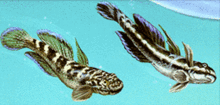- Sicyopterus stimpsoni
-
Nopoli rockclimbing goby 
Conservation status Scientific classification Kingdom: Animalia Phylum: Chordata Class: Actinopterygii Order: Perciformes Family: Gobiidae Genus: Sicyopterus Species: S. stimpsoni Binomial name Sicyopterus stimpsoni
(Gill, 1860)Synonyms Sicydium stimpsoni Gill, 1860
Sicyopterus stimpsoni ('cucumber-wing') aka the Nopoli rockclimbing goby, Oopu nopili, or Stimpson's goby, is a species of amphidromous fish in the Gobiidae family and is endemic to Hawaii.
Juveniles move from saltwater to freshwater streams shortly before changes in the anatomy of their mouths make eating plankton impossible. Their dietary behaviour depends critically on the benthic algal cycle, which is locked into the hydrological cycles of the island streams. [1]
The species in its adult form is found in the upper parts of clear, fast-running mountain streams, where there is clean gravel and rocks with no sedimentation, allowing the growth of algae on rock surfaces. It is found on all the Hawaiian islands, although it has become rare on O‘ahu. The species is herbivorous, feeding only on diatoms and filamentous algae, and vigorously defending its feeding patch. The males display brilliant blue and red colours during the breeding season, colours which change with the mood of the fish. The females attach their eggs to rocks where they are fertilised by the males, and the hatchlings are immediately washed downstream into the sea, where they develop, later to return to the freshwater pools upstream, where they live for several years. To arrive at these pools the juveniles need to climb the vertical rock under and beside very high waterfalls. The climbing is postponed until their mouthparts have moved from a forward-facing position to under the body. This change is effected in two days, altering their diet from that of an omnivore to feeding almost exclusively on algae growing on the rock surfaces, and not coincidentally enabling them to ascend slippery waterfall rocks by using mouth and pelvic suckers.
It is preyed upon by Black-crowned Night Herons and during its upstream migration through the estuary by Caranx spp., Polydactylus sexfilis and Sphyraena barracuda. [2]
Five of the seven endemic fish species on Hawaii are gobioid, and all of these gobioids are amphidromous stream dwellers, adapted to the steep torrents of Hawaiian mountains, and extremely sensitive to habitat disturbance.[3]
External links
References
- World Conservation Monitoring Centre 1996. Sicyopterus stimpsoni. 2006 IUCN Red List of Threatened Species. Downloaded on 5 August 2007.
- Froese, Rainer, and Daniel Pauly, eds. (2006). "Eleotris sandwicensis" in FishBase. April 2006 version.
Categories:- IUCN Red List near threatened species
- Sicyopterus
- Endemic fauna of Hawaii
- Fish of Hawaii
Wikimedia Foundation. 2010.

